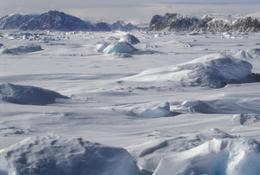Published online 3 December 2008 | Nature | doi:10.1038/news.2008.1275
News
Methane bursts from frozen tundra
Ice build-up may squeeze greenhouse gas from cold soil.
 As the Arctic tundra freezes it releases more methane. Punchstock
As the Arctic tundra freezes it releases more methane. PunchstockAs the autumn cold begins to bite in the Arctic tundra, the freezing ground releases a large and unexpected burst of methane into the air. The emissions, thought to be squeezed out by the growth of surface frost, match up with an atmospheric methane surge that had previously gone unexplained.
Scientists already knew that microbes breaking down organic debris in the northern wetlands emit considerable amounts of the greenhouse gas methane, a process that has been carefully measured for decades during the growing season. But it was widely assumed that methane production drops to nearly nothing over the winter, because colder soil can absorb more methane and falling temperatures slow the decay processes.
So the research teams that maintain automated methane-monitoring stations in high northern latitudes tended to abandon them around September, explains Torben Christensen, a biogeochemist at Lund University in Sweden.
But last year, as part of the research push for the International Polar Year, a field station in northeastern Greenland stayed open two months later than usual.
In those months, Christensen and his colleagues measured cumulative emissions as large as those recorded over the summer ? with peak rates at some collection points higher than had ever been seen in tundra (see 'A sudden surge of methane'). "I would have predicted the exact opposite finding," says Merritt Turetsky, a tundra expert from the University of Guelph, Canada, who was not involved in the study.
If all wet meadow tundras release a similar methane burst, the authors estimate, a previously unanticipated 4 million tonnes of the gas may be emitted each winter. That amount would not affect established estimates that Arctic wetlands release 30 million to 100 million tonnes of the gas annually. But the finding, reported this week in Nature1, fills a formerly puzzling gap.
Strange hump
Atmospheric scientists measuring methane above the Arctic always saw an unexplained rise in methane levels around autumn, says Edward Dlugokencky of the US National Oceanic and Atmospheric Administration, a co-author of the paper. When the researchers updated models of methane production with emissions from freezing soils throughout high northern latitudes, the results replicated the seasonal emissions hump.
The freezing process itself may squeeze out the surprising burst, the team suggests. As cold sets in, methane-saturated soil is sandwiched between spreading frost at the surface and a floor of permafrost below. Under pressure, the gas could escape via plant stems and roots, which perforate the layers like chimneys, says Christensen.
This is a far cry from the simple relationship between methane production and temperature usually used to model emissions, Turetsky notes.
Chris Field, an ecologist from the Carnegie Institution of Washington in Stanford, California, suggests an alternative mechanism, pointing out that an icy ceiling could block oxygenation of the soil, encouraging slow, methane-producing decay in the unfrozen layer, as opposed to the respiration processes that produce carbon dioxide in well-oxygenated soil.
"It seems to me that we don't exactly know the relative contribution of the squeezing mechanism they describe, compared with changes in the oxygen concentration, and the continued activity of the microorganisms that are still active in the non-frozen parts of the soil profile," says Field. "None of those explanations are inconsistent with the data they present."
But whatever the mechanism behind the new results, says Field, they add detail to geochemical models of Arctic processes. "One of the really important things we've learned about high-latitude processes over the last decade is that clearly a lot of stuff happens during what we had considered to be the wintertime, when everything is frozen and shut down."
Pinning down such details of the natural methane cycle, adds Christensen, could help to predict how climate change-induced thawing in the Arctic may release dangerous amounts of the greenhouse gas. "This will help us understand the starting point for those types of changes."
Link to article above: http://www.nature.com/news/2008/081203/full/news.2008.1275.html






No comments:
Post a Comment